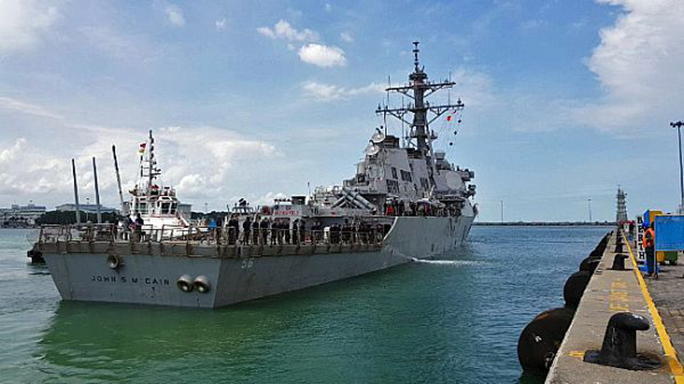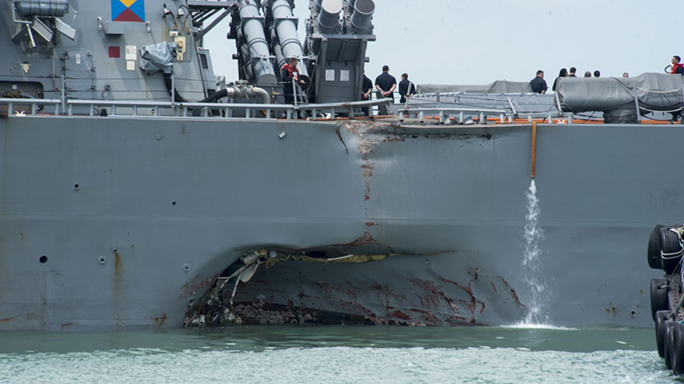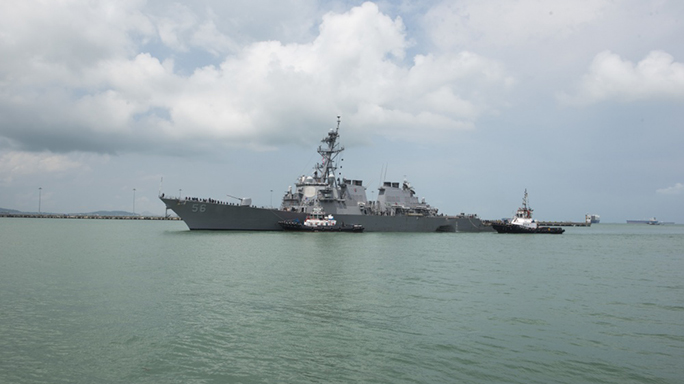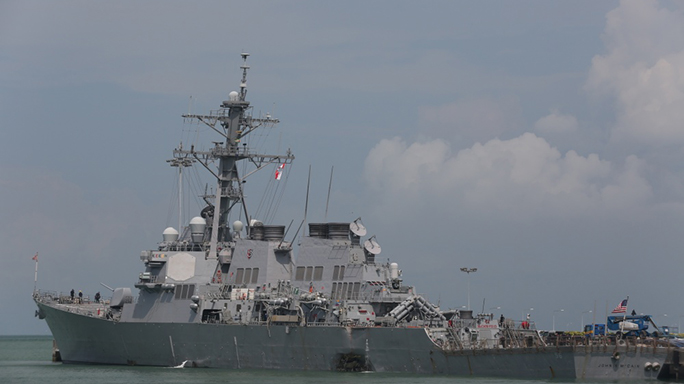The remains of some of the 10 sailors missing after a collision between a U.S. Navy Ship, the USS John S. McCain (DDG 56) and a merchant vessel called the Alnic MC east of the Strait of Malacca and Singapore, have been located, the service announced. Five sailors were also injured as a result of the incident. The ship is now at the Changi Naval Base in Singapore.
The Navy has been busy conducted search and rescue efforts in coordination with local authorities. Early this morning, Admiral Scott Swift, Commander of the Pacific Fleet, told reporters that divers discovered “some remains” of the missing sailors in sealed compartments aboard the ship. He also said the Malaysian Navy found “potential remains” during its search.
Swift didn’t get into specifics regarding the identity and number of the remains found.
Advertisement — Continue Reading Below
“Its premature to say how many and what the status recovery of those bodies is,” Swift said.
According to a Navy statement, the collision—which was reported at 6:24 a.m. Japan Standard Time on Aug. 21—resulted in significant hull damage, leading to flooding of nearby compartments, including crew berthing, machinery, and communications rooms. The crew conducted damage control efforts to stop further flooding.
- RELATED STORY: VIDEO – Marine Plane Crash Leaves 16 Dead in Mississippi
Four of the injured sailors have been medevac’d by a Singapore Armed Forces helicopter to a hospital in Singapore for non-life-threatening injuries. The fifth sailor didn’t require additional medical attention.
Advertisement — Continue Reading Below
The Alnic MC is a Liberian-flagged 600-foot oil and chemical tanker with a gross tonnage of 30,000, the Navy said.
As CNN points out, this marks the fourth time a U.S. Navy ship has collided with a vessel in Asian waters this year. In January, the USS Antietam ran aground while it attempted to anchor in Tokyo Bay. No injuries were reported. In May, the USS Lake Champlain (CG-57), a Ticonderoga-class cruiser, collided with a South Korean fishing boat while conducting “routine operations in international waters,” according to a Navy statement. Once again, no injuries were reported there. In June, however, the USS Fitzgerald (DDG-62), an Arleigh Burke-class destroyer, collided with a Philippine-flagged container ship off the coast of Japan, killing seven sailors.
Now, in the wake of the latest incident involving the USS John S. McCain, Chief of Naval Operations Admiral John Richardson issued a video statement ordering an “operational pause” for all Navy fleets, in order for “fleet commanders to get together with their leaders and their commands to ensure that we’re taking all appropriate immediate actions to ensure safe and effective operations around the world.”
Advertisement — Continue Reading Below
In addition to that, Richardson has ordered a comprehensive review of the root causes of incidents like the USS John S. McCain and USS Fitzgerald.
“We will examine the process by which we train and certify our forces that are forward-deployed in Japan to make sure that we are doing everything we can to make them ready for operations and warfighting. This will include but not be limited to looking at operational tempo, trends in personnel, materiel, maintenance and equipment. It will also include a review of how we train and certify our surface warfare community including tactical and navigational proficiency,” Richardson said.
According to the Atlantic, the Strait of Malacca, where the USS John S. McCain collision occurred, is historically one of the busiest shipping routes and chokepoints, with nearly 100,000 vessels passing through it annually. Along with an extremely high volume of traffic, it’s also one of the narrowest straits in the world, measuring 1.5 nautical miles—1.7 miles on land—at its narrowest point, the Phillips Channel, near Singapore.
Advertisement — Continue Reading Below



























